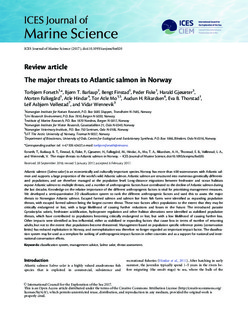| dc.contributor.author | Forseth, Torbjørn | |
| dc.contributor.author | Barlaup, Bjørn Torgeir | |
| dc.contributor.author | Finstad, Bengt | |
| dc.contributor.author | Fiske, Peder | |
| dc.contributor.author | Gjøsæter, Harald | |
| dc.contributor.author | Falkegård, Morten | |
| dc.contributor.author | Hindar, Atle | |
| dc.contributor.author | Mo, Tor Atle | |
| dc.contributor.author | Rikardsen, Audun H. | |
| dc.contributor.author | Thorstad, Eva Bonsak | |
| dc.contributor.author | Vøllestad, Leif Asbjørn | |
| dc.contributor.author | Wennevik, Vidar | |
| dc.date.accessioned | 2018-03-20T13:01:22Z | |
| dc.date.available | 2018-03-20T13:01:22Z | |
| dc.date.created | 2017-03-31T08:12:21Z | |
| dc.date.issued | 2017 | |
| dc.identifier.citation | ICES Journal of Marine Science. 2017, 74 (6), 1495-1513. | nb_NO |
| dc.identifier.issn | 1054-3139 | |
| dc.identifier.uri | http://hdl.handle.net/11250/2491280 | |
| dc.description.abstract | Atlantic salmon (Salmo salar) is an economically and culturally important species. Norway has more than 400 watercourses with Atlantic salmon and supports a large proportion of the world’s wild Atlantic salmon. Atlantic salmon are structured into numerous genetically differentiated populations, and are therefore managed at the population level. Long-distance migrations between freshwater and ocean habitats expose Atlantic salmon to multiple threats, and a number of anthropogenic factors have contributed to the decline of Atlantic salmon during the last decades. Knowledge on the relative importance of the different anthropogenic factors is vital for prioritizing management measures. We developed a semi-quantitative 2D classification system to rank the different anthropogenic factors and used this to assess the major threats to Norwegian Atlantic salmon. Escaped farmed salmon and salmon lice from fish farms were identified as expanding population threats, with escaped farmed salmon being the largest current threat. These two factors affect populations to the extent that they may be critically endangered or lost, with a large likelihood of causing further reductions and losses in the future. The introduced parasite Gyrodactylus salaris, freshwater acidification, hydropower regulation and other habitat alterations were identified as stabilized population threats, which have contributed to populations becoming critically endangered or lost, but with a low likelihood of causing further loss. Other impacts were identified as less influential, either as stabilized or expanding factors that cause loss in terms of number of returning adults, but not to the extent that populations become threatened. Management based on population specific reference points (conservation limits) has reduced exploitation in Norway, and overexploitation was therefore no longer regarded an important impact factor. The classification system may be used as a template for ranking of anthropogenic impact factors in other countries and as a support for national and international conservation efforts. classification system, management advice, Salmo salar, threat assessment. | nb_NO |
| dc.language.iso | eng | nb_NO |
| dc.publisher | Oxford University Press | nb_NO |
| dc.rights | Navngivelse 4.0 Internasjonal | * |
| dc.rights.uri | http://creativecommons.org/licenses/by/4.0/deed.no | * |
| dc.title | The major threats to Atlantic salmon in Norway | nb_NO |
| dc.type | Journal article | nb_NO |
| dc.type | Peer reviewed | nb_NO |
| dc.description.version | publishedVersion | nb_NO |
| dc.subject.nsi | VDP::Marinbiologi: 497 | nb_NO |
| dc.subject.nsi | VDP::Marine biology: 497 | nb_NO |
| dc.source.pagenumber | 1495-1513 | nb_NO |
| dc.source.volume | 74 | nb_NO |
| dc.source.journal | ICES Journal of Marine Science | nb_NO |
| dc.source.issue | 6 | nb_NO |
| dc.identifier.doi | 10.1093/icesjms/fsx020 | |
| dc.identifier.cristin | 1462610 | |
| dc.relation.project | Miljødirektoratet: Atlantic salmon Committee | nb_NO |
| dc.relation.project | Norges forskningsråd: 179569 | nb_NO |
| cristin.unitcode | 7464,30,23,0 | |
| cristin.unitname | Nedbørfeltprosesser | |
| cristin.ispublished | false | |
| cristin.fulltext | original | |
| cristin.qualitycode | 1 | |

